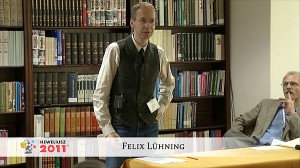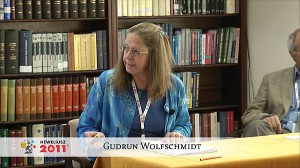Konferencja Hevelius 2011 – Sesja 2 – James Caplan
 Temat: Instrumenty Heweliusza i ich krytyczna ocena ze strony Hooke’a.
Temat: Instrumenty Heweliusza i ich krytyczna ocena ze strony Hooke’a.
W 1674 roku Robert Hooke wydał Animadversions on the first part of the Machina Coelestis, w której to pracy ostro skrytykował Heweliusza za niewykorzystywanie w pomiarach pozycyjnych przyrządów optycznych (tak jak czynili to z sukcesem Picard i Flamsteed). Heweliusz bowiem posługiwał się instrumentami, których konstrukcja nawiązywała do instrumentów Tychona Brahego, powstałych pod koniec XVI wieku. Hooke dowodził, że z powodu braku teleskopowych przeziemic pomiary Heweliusza są z konieczności ograniczone w swej dokładności przez zdolność rozdzielczą oka ludzkiego, nie mniejszą niż minuta kątowa. Gdy jednak do Heweliusza przybył z Anglii Edmond Halley i przeprowadził razem z nim obserwacje, potwierdził, że instrumenty gdańszczanina pozwalają na pomiary z dokładnością większą niż minuta kątowa. Kwestię tę czasami zbywa się stwierdzeniem, że Heweliusz i Halley mieli niezwykle ostry wzrok. Tymczasem o dokładności pomiarów wykonywanych instrumentami typu Brahego i Heweliusza decydują ich cechy dyfrakcyjne.
materiał w języku angielskim
James Caplan (Observatoire astronomique de Marseille-Provence):
Hooke’s Criticism of the Tychonic Instruments of Hevelius
In 1674, Robert Hooke published his Animadversions on the first part of the Machina Coelestis, in which he severely criticised Hevelius for not using telescopes as pointing devices for his measurements of celestial positions (as Picard and Flamsteed were doing with much success). Instead, Hevelius was using instruments inspired by those invented by Tycho Brahe in the late 16th century. By not using telescopic sights, Hooke argued, the measurements of Hevelius were necessarily limited in accuracy by the resolution of his eyes, certainly no better than an arcminute. But when Edmond Hailey was sent from England to meet with Hevelius and use his instruments, Hailey confirmed that Hevelius’s instruments allowed reproducible sub-arcminute measurements. This mystery has sometimes been dismissed by saying that Hevelius and Hailey had unusually sharp eyesight. The true explanation is that Tychonic instruments are limited by their diffraction characteristics.


